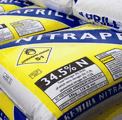Fertiliser market report

Fertiliser prices in Britain have reached unprecedented levels, a situation that is tolerable only because the value of milk and cereals has also risen. But which came first?
What we are witnessing is a classic application of the rules of supply and demand.
Fertiliser supply is relatively inelastic because new plants or mines cannot be opened or built quickly, so when demand for nutrients increases, products is sold to the highest bidder and prices go up.
Inflated prices
And, global demand for grain is massive.
UK manufacturers are forced to buy P and K raw materials at inflated prices and these must be passed on to the farmer.
Unfortunately we in the UK are used to the cosy world of the 1980s when domestic supply and demand held sway, and it is hard to reconcile ourselves to the cut and thrust of a genuinely global fertiliser economy.
Volatility
The volatility in costs is such that the industry has been forced to pause and take stock.
The market therefore is inactive as manufacturers have withdrawn terms.
Prices in the table are therefore best estimates for January, which is expected to be the next month for which pricelists are published.
Less rosy for root growers
However, even with farm prices of £195 for AN, £330 for diammonium phosphate and £230 for muriate of potash, the equation can balance out.
These would represent an increase of £25 to £30 per acre in nutrient costs for wheat, whilst output values rise by £250.
The balance remains positive for OSR and dairy enterprises but looks less rosy for root growers and beef and sheep enterprises.
Prices come down as well as up
Some merchants anticipate that fertiliser will be on allocation in the spring and that we can expect ammonium nitrate to finally reach £200/t by March.
As building society adverts are so fond of telling us, prices can come down as well as go up, and this is undoubtedly true in the case of commodities following those inescapable laws of economics.
But, there is always a base in the market and whilst fertiliser prices will eventually undoubtedly come back, they will return to a base that is significantly higher than before.
Sourcing nightmare
Let us hope that a higher base is also to be expected in output prices.
The markets in Northern Ireland and in the Republic of Ireland are also affected, but perhaps worse so, because farmers there tend to buy the major tranche of their supplies at the usage period.
Merchants are experiencing a nightmare in sourcing product at prices that will be credible to their spring buyers.
Straight | |||||
Domestic N | Imported AN | Imported urea | Liquid UAN (28.8 %N/t) | ||
around £195 January | Limited imports £188 | Granular £250 Prilled no interest | £200+ | ||
£300+ tight availability |
| |
Muriate of Potash (60%K2O) | £230 |
|
Compound | |||||
N.P.K | Complex | Blended | |||
25.5.5 | £200 | From £190 | |||
15.15.20 | £249 but priced out of market |
| |||
20.10.10 / 27.5.5 | £212-215 | From £205 | |||
17.17.17 | No market |
| |||
Aftercuts (NK) | No market | ||||
27.6.6 (imported) |
|
| |||
32.5.0 (imported) |
| No market | |||
Autumn grades (PK) | £240+ | ||||
Trace elements | Copper, zinc, selenium, |
| Urea | CAN | 25.0.13 | 25.5.5 | 27.6.6 |
| No market | No market | No market | £220 | No longer used Phosphate regulations |
| No market | No market | No market |
| €320 ( |
†Note in the
*Known as 24.2½.10 blend in the
**Known as 27.2½.5 in ROI
Note: All illustrated prices are based upon 24 tonne loads for immediate payment. Prices for smaller loads and those with credit terms will vary considerably.
Source:

